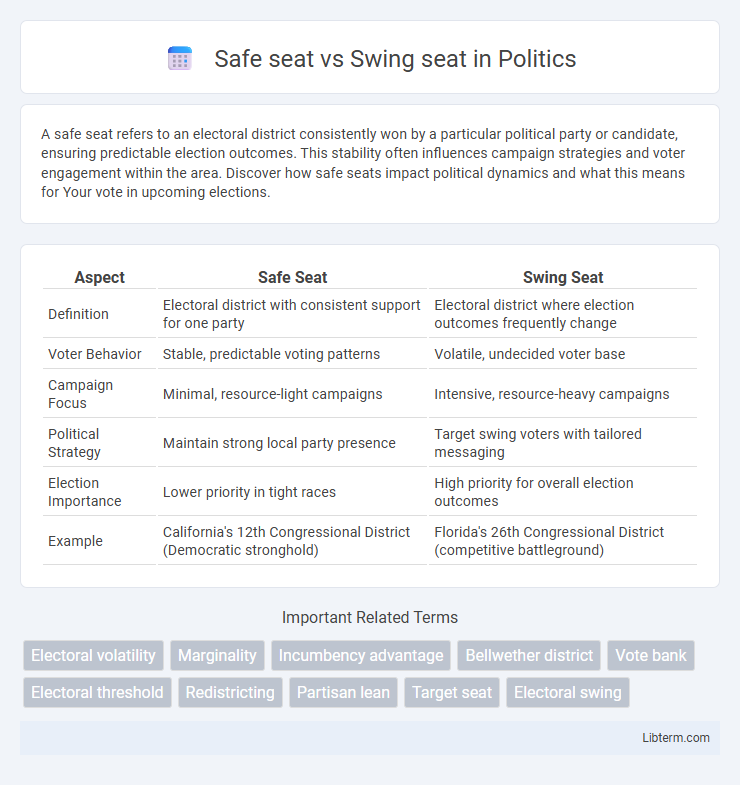A safe seat refers to an electoral district consistently won by a particular political party or candidate, ensuring predictable election outcomes. This stability often influences campaign strategies and voter engagement within the area. Discover how safe seats impact political dynamics and what this means for Your vote in upcoming elections.
Table of Comparison
| Aspect | Safe Seat | Swing Seat |
|---|---|---|
| Definition | Electoral district with consistent support for one party | Electoral district where election outcomes frequently change |
| Voter Behavior | Stable, predictable voting patterns | Volatile, undecided voter base |
| Campaign Focus | Minimal, resource-light campaigns | Intensive, resource-heavy campaigns |
| Political Strategy | Maintain strong local party presence | Target swing voters with tailored messaging |
| Election Importance | Lower priority in tight races | High priority for overall election outcomes |
| Example | California's 12th Congressional District (Democratic stronghold) | Florida's 26th Congressional District (competitive battleground) |
Understanding Safe Seats and Swing Seats
Safe seats are electoral districts consistently won by the same political party, characterized by high voter loyalty and predictable outcomes in elections. Swing seats, also known as marginal seats, have a history of fluctuating support between parties, making them critical battlegrounds that often determine overall election results. Understanding the dynamics of safe and swing seats helps political strategists allocate resources effectively and predict electoral shifts.
Key Differences Between Safe Seats and Swing Seats
Safe seats consistently exhibit a strong voter base for a particular political party, resulting in predictable election outcomes with minimal campaign investment. Swing seats, characterized by volatile voter preferences and narrow margins, require intense campaigning and targeted strategies due to their potential to change party control. The electoral significance of swing seats lies in their decisive role in determining overall election results, whereas safe seats contribute to electoral stability.
The Role of Safe Seats in Political Stability
Safe seats provide political stability by ensuring consistent party representation, reducing electoral volatility and allowing long-term policy planning. They enable incumbents to focus on governance and constituent services without the constant pressure of competitive campaigns. This stability supports effective legislative collaboration and sustained political strategies within governing bodies.
Why Swing Seats Matter in Elections
Swing seats matter in elections because they represent constituencies where voter preferences are highly competitive and can change between parties, making them critical battlegrounds that determine overall election outcomes. These seats often receive the most campaign attention, resources, and strategic focus from political parties, as winning them can shift the balance of power. Unlike safe seats with predictable voting patterns, swing seats reflect shifting public opinion and voter behavior, making them key indicators of electoral momentum and political trends.
Factors That Define a Safe Seat
Safe seats are electoral districts with a consistent history of voting for a particular party, often characterized by a high margin of victory exceeding 10%. Key factors defining a safe seat include strong party loyalty among voters, demographic stability, and effective incumbent presence, which minimize electoral volatility. In contrast to swing seats, safe seats face less competitive pressure during elections due to predictable voting patterns and entrenched political support.
Characteristics of Swing Seats
Swing seats feature highly competitive electoral districts with fluctuating voter support, making them crucial battlegrounds in elections. These seats often exhibit diverse demographics and unpredictable voting patterns, resulting in narrow victory margins and frequent shifts between political parties. Campaign strategies in swing seats prioritize targeted messaging and voter engagement to sway undecided or moderate constituents effectively.
Impact on Campaign Strategies
Safe seats allow political parties to allocate fewer resources and maintain predictable voter bases, enabling concentrated efforts on policy promotion. Swing seats require intensive campaign strategies, including targeted voter outreach, frequent advertising, and tailored messages to persuade undecided or fluctuating electorates. The dynamic nature of swing seats often dictates overall election outcomes, making them critical battlegrounds in campaign resource allocation.
Voter Behavior in Safe vs Swing Seats
Voter behavior in safe seats tends to be more predictable, with strong party loyalty and higher voter turnout due to perceived electoral stability. In contrast, swing seats exhibit fluctuating voting patterns as voters are more responsive to campaign efforts, policy changes, and candidate appeal, resulting in increased electoral volatility. This dynamic influences political strategies, with parties allocating more resources to swing seats to sway undecided or fickle voters.
Recent Trends in Safe and Swing Seats
Recent trends indicate a decline in traditional safe seats as demographic shifts and increased political awareness contribute to unpredictable voter behavior. Swing seats have gained prominence due to their decisive role in determining election outcomes, with data showing heightened campaign investments and targeted advertising in these regions. The emergence of new voter blocs and changing social attitudes further blur the distinction between safe and swing seats, leading to more dynamic and competitive electoral landscapes.
Implications for Future Elections
Safe seats, characterized by predictable party dominance and high incumbent retention rates, reduce campaign competition and resource allocation, potentially leading to voter apathy and decreased political engagement. Swing seats, often decided by narrow margins and shifting voter preferences, attract significant campaign investment and can serve as critical determinants of overall election outcomes and parliamentary balance. Future elections may hinge on changes in demographic trends and policy priorities within swing seats, increasing their strategic importance for political parties aiming to secure legislative majorities.
Safe seat Infographic

 libterm.com
libterm.com